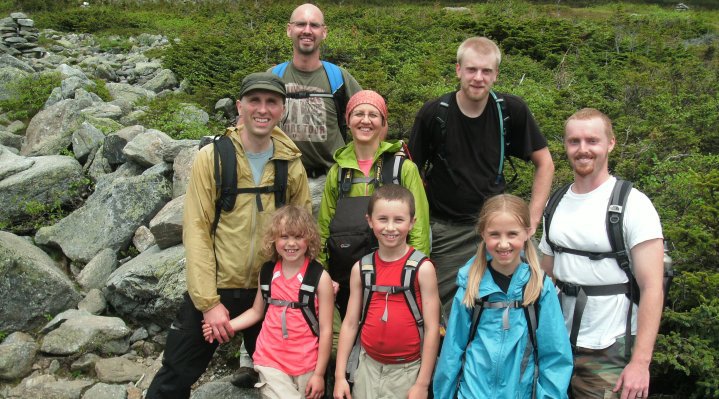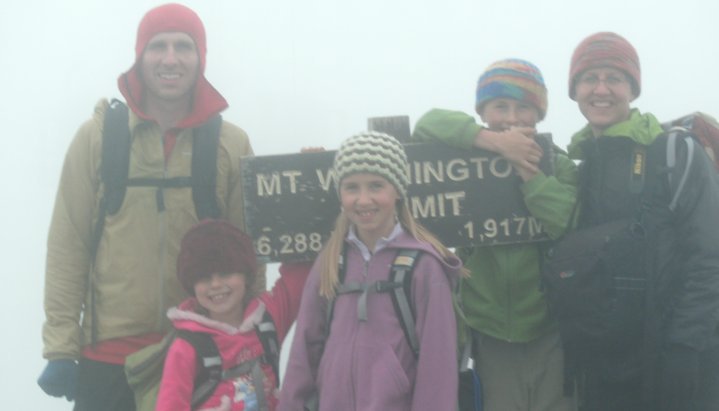
Not too long ago, I embarked with a group of seven others to climb the tallest mountain in New England. You may remember that I climbed Mount Washington for the first time last year (trip report here). Even though our route was the same, the second time around brings with it a completely new experience and many new insights that weren’t apparent upon the first ascent. Granted, Mt. Washington is little more than a hill compared to the Rocky Mountains and many others around the world. Still, it’s far more challenging than most climbs – and one of the most challenging day hikes on this side of the U.S.A.
There have been hikes that upon completion, have left me utterly exhausted. This was not one of them. Yes, there was fatigue. Yes, there was need of rest. But to such a lesser extent compared to many other hikes I’ve done. If anything, I felt tired, but also rejuvenated after finishing. During last years trip, I noticed that I was far less fatigued than I had expected to be from such a grueling hike. This time, I’ve experienced minimal fatigue while climbing and after finishing – to an even greater degree, and I think I know why.
After this trip, I have reaffirmed those 3 beliefs about why this was less strenuous than I had imagined it could be. The physical conditioning required for hiking is one of them. If you’re physically prepared, then of course, you’ll experience less fatigue. Along with that, the mindset adjustment needed to take your time and not rush – to get out of your normal zone of GO GO GO, and just enjoy the process rather than rush to complete a goal. Rushing almost always creates fatigue, so taking our time also helped a lot. But on top of that, was the choice to go barefoot. This year, I both ascended and descended barefoot, which contributed, in part, to one of the best hiking experiences I’ve ever had. I packed a pair of Vibram FiveFingers just in case I needed them, but never resolved to put them on (though the temptation was there as my soles began to get tender).
Though I didn’t mention it in last years trip report, my knees began getting fairly achy upon my descent while wearing shoes. It wasn’t a “this is a serious problem and you need to stop” type of achiness, but more of a general discomfort. I’d rank it at a 4/10 on a discomfort scale of 1-10 (10 being the worst pain I’ve ever felt). Up until I had put shoes on, my knees felt great – not even a hint of an issue while going barefoot up to the summit. However, shortly after I put shoes on, the knees began to act up, and I dealt with it the whole way down.
During this more recent climb, I experienced very little joint discomfort at all. I’d rank my knees at a discomfort level of 1/10 for the whole hike. I think this is largely in part because I went barefoot the whole way. There are a lot of reasons that going barefoot could contribute to this, but the main one is that you walk more gently when barefoot than when shod. My knee pain during last years trip was presumably because of the tens of thousands of impacts I subjected myself to all the way down the mountain. Moving down the mountain with gravity, with a pack on, while already fatigued didn’t help the situation either. Not only that, but I had well-supported, highly-cushioned shoes to deaden the impact and block out the normal signals that my feet would be sending me and greatly limit my normal range of motion in my feet and ankles. It’s logical to assume that all of those factors led to achy knees.
 When you’re barefoot, you can’t sustain high-impact producing activities for very long – certainly not for miles down a mountain over rugged terrain. You MUST walk gently because you’ll be in pain or even get injured as soon as you get careless and start landing heavily.
When you’re barefoot, you can’t sustain high-impact producing activities for very long – certainly not for miles down a mountain over rugged terrain. You MUST walk gently because you’ll be in pain or even get injured as soon as you get careless and start landing heavily.
As a side note, last year when I would take my Vibram’s with me for a run, I would begin the run completely barefoot, and then would put them on when my feet began to get very tender. Immediately upon putting them on, I noticed a stronger propensity towards heavier footstrikes, even when consciously trying to soften my landings. There might be a possibility of being able to consciously control your footstrikes so that you land gently while running or hiking in footwear, but I know that it’s much harder to do when you don’t have that direct feedback from your soles being directly in contact with the earth. That said, I think it’s possible to walk and run gently in footwear – it just takes practice.
For this particular hike, going barefoot indirectly contributed to minimize knee pain, prevent excessive fatigue, and improve the overall experience. I will be hiking completely barefoot whenever possible from this point forward.
The other element that made this hike interesting was that this was the first full day hike that I’ve done completely fasted. My last meal was dinner the night before, and I didn’t bring any food along to tempt me during the hike. What I noticed was a brief period of hunger on the way up, a stronger temptation to eat at the top, and I spotted a few possible food sources that would have otherwise gone unnoticed (mostly plants, animals, and small children). Other than that, the trip really wasn’t any different than any other hiking trip I’ve taken. Like I said above, I didn’t experience much fatigue, and my recovery from the hike the following days was typical.
I’m a fan of intermittent fasting for health reasons, and I’ve often wondered how prolonged vigorous physical activity would affect someone in a fasted state. I may be bringing some more info about this subject in the future.
In closing, I can attest that this was one of the most enjoyable hikes I’ve ever done. It was a wonderful day all-around for many reasons – mostly because I got to spend time with some of my favorite hiking pals. On top of that, the beautiful weather, the breathtaking views, the uncrowded trails and the excellence of a new adventure all made for an unforgettable day.
One last thing… with my unrelenting affinity for pursuing the principles of progression and variation – next year, I’ll be hiking Mt. Washington barefoot, fasted, AND naked. I’ll be posting my trip dates in advance for anyone who’d like to join me or to make sure you’re NOT hiking that day. Happy trails!

.jpg)
![]()
CST, CST-KS, NSCA-CPT
Fitness Professional
Great trip report! I had no idea you had knee problems on your last hike.
I’m not sure if I’ve told you about my “full history” of knee issues. It’s quite a story actually, and I’ll have to fill you in sometime.
John, I really appreciate your posts (however infrequent they may be)! I’ve been barefoot running for about a year now on smooth cement and have been a little scared to try it off road. You have given me new motivation!
Hey Jason,
Thanks for that. I would highly recommend you take your barefoot training off-road. It sounds like you’ve spent enough time to build a good foundation, and now it’s a good time to sophisticate your training. Going trail running or hiking would be just the thing. Do keep in mind to take it incredibly slow. It’s too easy to go gung-ho and wind up injuring yourself, and I’d hate for that to happen. I think that after you’ve eased into it, you’ll start to love the new challenge and adventure it brings.
nice work guys! oh and Mt Mitchell is the highest mountain on the east coast…but Mt Washington is way gnarlier! great on ya!
Thanks Skye – don’t know why I said the East Coast.
Finally read this post! If you’re naked buddy you can count me out as hiking partner!
hahaha, don’t worry Renee. I’ve already got someone else to commit to the trip… Ronin :)
I’ve hiked Mt. Washington every year for the last three years. This year I struggled on the way down because of having uncomfortable shoes and knee problems (both of which I’ve never experienced). I’ve never done a major hike barefoot, but I’m wondering if you are on to something. Definitely worth thinking about.
Hi Kati,
Thanks for your comment. I definitely recommend giving it a try barefoot next year, but it’s not something you can just do without any preparation. It can and should take weeks or months to prepare your body for a strenuous barefoot hike, especially on the rough terrain of Mt. Washington. There’s a lot of info here on Physical Living about going barefoot that can get you started – just use the search function at the top.
I can’t recall reading in your post about the length of your hike. Since you were barefoot and obviously walking gently do you know how much longer your hike took than a hike up Mt Washington with shoes?
I can’t recall the actual duration, but it was no longer than it would take anyone with shoes. We were actually passing other hikers on our way up and down. Walking gently doesn’t mean walking slowly ;)
Yesterday, Thursday October first 2015. 3 of us hiked up Huntington’s ravine, to the summit and back down loin’s head barefoot. Do you know if anyone has hiked up that route barefoot before? It was an amazing experience, 33 degrees at the top. We showed up barefoot and shirtless, folks thought we were crazy!! Hope to hear from you soon:)
Awesome! I’ve done Washington three times now – always barefoot – and I took the same route you did on my most recent trip. Had my shirt on, though!
Cool! Have you done Adams barefoot? We are interested in so summiting more mountains barefoot:)
I don’t recall ever hiking Adams, but I’ve done almost all of my hiking since 2009 barefoot. By far, my favorite day hike has been the Lafayette, Lincoln, and Little Haystack loop. I’ve done that loop twice – both times barefoot. Recommended!